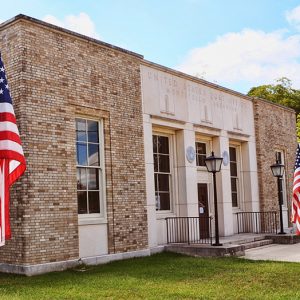calsfoundation@cals.org
Monticello Post Office (Historic)
The 1937 Monticello Post Office in Monticello (Drew County) is a one-story, brick-masonry structure designed in a restrained interpretation of the Art Deco style of architecture and featuring a sculpture created through the U.S. Treasury Department’s Section of Painting and Sculpture (later renamed the Section of Fine Arts), a Depression-era stimulus project that promoted public art. The post office was listed on the National Register of Historic Places on August 14, 1998.
Construction began on the Monticello Post Office in early 1937, with the Advance Monticellonian reporting on January 28 that “work on the new post office began in earnest last Monday morning.” The blond-brick structure “will be of the same material and color as the [adjacent] Municipal Building, and upon completion will add much to the latter,” the article said.
Two years later, Monticello postmaster Guy Stephenson requested in a November 3, 1939, letter to the Federal Building Administration Department of Fine Arts “consideration by your Bureau of having a ‘MURAL’ painted on the Walls of our New Post Office Building which was completed here two years ago, and in which the citizens of Monticello and Drew County take much pride and interest.” The postmaster’s request was a departure from the normal process by which Section art was acquired in the state; in virtually every other case, such art was written into the initial building specifications, and the U.S. Treasury Department’s Section of Fine Arts took the lead in seeing that murals or sculptures were placed in the structures.
A week later, Stephenson’s request was followed by one from Representative William F. Norrell, Arkansas’s Fourth District congressman and a Monticello native. The Section quickly discovered that $881 remained from the Monticello Post Office construction budget and requested that $750 be set aside for art for the building. On December 6, 1939, the office of the Commissioner of Public Buildings notified Norrell that the $750 was authorized for “the decoration in question.”
Inslee A. Hopper, consultant to Section Chief Ed Rowan, wrote New York artist Berta Margoulies on March 11, 1940, inviting her to submit designs for a sculpture for the Monticello building. Margoulies—a Polish-born sculptor trained at the Academie Julian, Ecol des Beaux-Arts in Paris, France—accepted the commission a week later, calling it “a nice surprise.” Postmaster Stephenson remained an active participant in the project, writing to the Section on April 12 that “it is desired that you inform me with further reference to this decoration, if I am to take any action in regard to the matter, or to know if this decoration will or should have any reference to local history or some eventful illustration connected with this section.” In a September 14 letter accompanying her sketches of the proposed sculpture, Margoulies wrote that “since Monticello is known as the ‘Tomato Capital of Arkansas’ and the community apparently takes great pride in its ranking industry, I have chosen tomato culture as the subject matter.”
The three-panel sculpture, to be executed in terra cotta, included a 4’3″ wide by 2’4″ tall center panel and two flanking panels measuring 2’3″ wide by 2’6″ tall. A December 7, 1940, letter from the artist reveals some of the complications inherent in creating large, wall-mounted sculptures (each panel weighed some 220 pounds). In submitting photographs of the central piece, Margoulies noted that the sculpture was cut in half, “necessary for firing such a large terra cotta.” However, the cut was located in an “overlapping of forms, and will not be noticeable at all when the relief is fitted into the wall, both because the two parts will come closer together when placed and because retouching will be done if at all necessary.”
Margoulies wrote from Monticello on December 24 that she was ready to install the sculpture. Postmaster Stephenson confirmed installation in a December 31 letter, noting that it took five days to hang the three-piece work and that he was “pleased to state that so far as I can see or understand the project is completed in good condition and fully complies with the photographic outlines and specifications.”
Shortly after the post office was listed on the National Register in 1998, the postal service moved into a new building. The Monticello Post Office became home to the offices of the Monticello Economic Development Commission.
For additional information:
“Arkansas Post Office Murals.” University of Central Arkansas. http://uca.edu/postofficemurals/home/ (accessed September 7, 2021).
Arkansas Post Office Murals Records. Arkansas State Archives, Little Rock, Arkansas.
“Monticello Post Office.” National Register of Historic Places nomination form. On file at Arkansas Historic Preservation Program. Online at http://www.arkansaspreservation.com/National-Register-Listings/PDF/DR0018.nr.pdf (accessed September 7, 2021).
Smith, Sandra Taylor, and Mark K. Christ. Arkansas Post Offices and the Treasury Department’s Section Art Program, 1938–1942. Little Rock: Arkansas Historic Preservation Program, 1998. Online at http://www.arkansaspreservation.com/News-and-Events/publications (accessed September 7, 2021).



 Monticello Post Office
Monticello Post Office 



Comments
No comments on this entry yet.